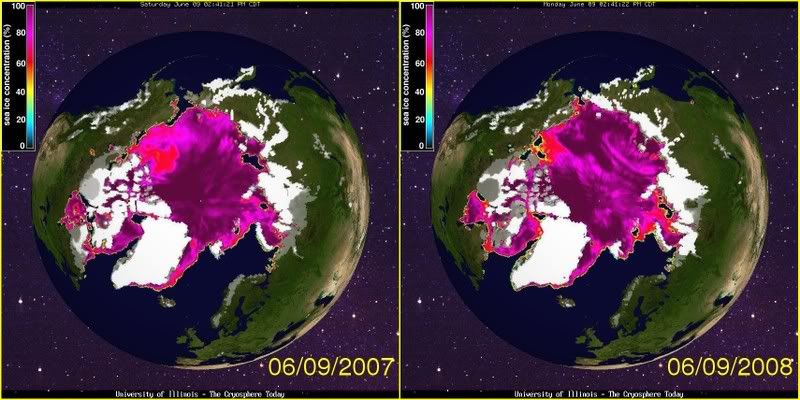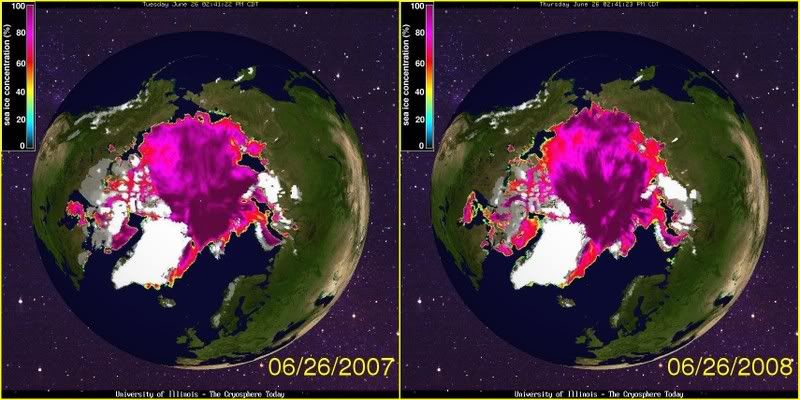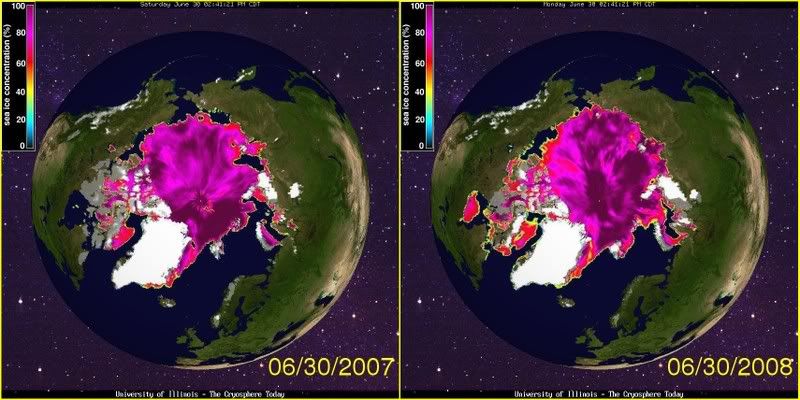The Arctic ice melt has begun. By the time it ends around September the results may, or may not be significant as far as climate effects are concerned, but any noticeable change from last year in one direction, or the other will have tremendous effect as far as the message you will receive from the mainstream media. If the melt is noticeably greater headlines will scream the earth is doomed. If it is noticeably less you most likely won't hear about it, except from the odd message poster thumbing his nose at the alarmist crowd.
Here's an update on the general thinking of what will happen.
2008 media predictions on 2008 Arctic melt
Basically the general thinking seems to be expect a melt greater even than the freakish melt of last year.
My money's on "noticeably less than last year". Call it a hunch.
Here's a graphic of what's happening so far, and a link to where you can update. June 9 2007 is on the left. June 9 2008 is on the right.
Arctic Melt Viewer
Basically the darker the purple, the deeper the ice. Nothing really significant so far. Maybe it was melting a little earlier in 2007. Hard to tell. When the melt clicks into full swing though everything will happen in a hurry.
Things are starting to move along now...
June 26 20007 against June 26 2008
June 30 2007 against June 30 2008
Notice Hudson's Bay had melted this time last year.
There's some possibly deceptive information out there. The alarmist story is the recent melt this year has been more rapid than last year. What they don't tell us is the record refreeze this year made the ice pack larger than the ice pack last year. The ice on the outer edge of this year's ice pack was shallow, and melted quickly. That's the story I heard anyway. Feel free to check it out. It's possible I'm wrong. Nevertheless, to me anyway, this year's arctic ice pack now looks larger.
![]() more alarmists Bullshit but western Canada in a deep freeze for 2 weeks at the end of April is proof of nothing
more alarmists Bullshit but western Canada in a deep freeze for 2 weeks at the end of April is proof of nothing ![]()
Well, it's about 30 here in North Vancouver, and it's gotten up top 30 the last two days as well. This is irrefutable proof of global warming.
Which brings up an interesting question. If the Arctic ice melt should turn around and become significantly larger, or remain smaller this year than last, will that actually prove anything?
I mean the Antarctic ice pack is still growing, and the global icepack was pretty much the same as it was 29 years ago the last time I looked. So does a recent localized warm patch in the Arctic even mean anything. Even if the Icepack should all of a sudden melt like there's a volcano under it (which there is), will that mean we need more carbon taxes.
The mainstream media will be telling us it does. Unless of course an increased melt doesn't happen, then as I said earlier we won't hear from them.
No, it provides more factual basis for predictive models. For instance, it will provide evidence against alarmists who say we are heading into an ice age.
It seems global warming isn't all that global.
I'm waiting to hear that global warming/cooling/climate change caused the volcanos, just like tornados, tsunamis and hurricanes..
I voted "Noticeably less melt than last year." and I expect to be right.
Global warming killed the dinosaurs, too.
It seems global warming isn't all that global.
Myself, just by the different bits I'm picking up here and there, I don't think the underwater volcanic activity matters much. But it is a little tiny bit you can add to the other possible (in some cases probable) explanations for last year's melt.
* Unusual south blowing winds in Atlantic. Icebergs were swept south, and didn't buttress existing ice, and coastal glaciers.
* Arctic Oscillation may have shifted last year. Something to do with salinity happened.
* PDO did shift out of it's warm phase this year.
* Something happened with the AMO. Can't remember what.
* An unusual amount of cloudless skies over Greenland last year.
* Soot.
And yes, maybe even a little greenhouse warming.
As Freeman Dyson said:
(Emphasis mine). The whole speech is awesome, I think. You might like it, too, given that he opens:
http://www.edge.org/documents/archive/edge219.html#dysonf
Global warming killed the dinosaurs, too.
I thought they froze their nuts off...oh right it's all the same thing
The Australian press must have the highest concentration of idiots. I mean alarmists.
http://www.abc.net.au/news/stories/2008 ... tion=world
There's some new info you're unlikely to hear about in the mainscream media, so here it is just in case anybody's interested. It's just a graph.
http://nsidc.org/data/seaice_index/imag ... series.png
I'll explain why I think it's significant.
You may recall how a few months back the media was telling us to be scared, because the melt in the arctic was more rapid this year than it was last. Here's what they didn't tell you.
Last year's melt was freaky. There were a lot of possible reasons for that having more to do with natural phenomena than human caused, greenhouse warming. Nevertheless last year's Arctic melt was large, and unusual. What was even more unusual however was there was a record refreeze this winter beyond 2007 levels. It, like the 2007 melt, was quicker than anything on the satellite record. If one was only receiving mainstream information they wouldn't have heard about that last bit.
Outside the mainstream however, there was discussion. The one side said all this extra ice wouldn't matter because, it was all recent ice, and therefore thinner. They even invented new terms to replace the accepted ones of perennial ice, and multi-year ice. (Perennial is the ice that lasts through a melting season. Multi-year is the ice that lasts, not surprisingly, multiple years). Some global warming alarmists now grouped it all into what they were calling "New Ice", and "Old Ice".
So anyway the claim was all this, what they were calling "new ice" would melt quickly and the "old ice" would then be melted away.
However, here's what actually happened. You can see it on the graph linked to above. Some of the excess thin ice on the outside perimeter of the pack did melt rapidly in the early part of the year. At this point media screamed headlines of the event, and advised fear. The melt then slowed as it hit the thicker stuff. Although the media was quick to show the early rapid melt, they're not showing you what's happening now. 2007's melt continued to gain force. 2008's melt is now following the line of the old unremarkable melt. In other words compared to last year's melt 2008's has slowed. The results are now visible to the naked eye on a satellite view.
Here's a link to the way the melt looks today.
2007 Actic ice pack for June 10 versus June 10 2008.
Looks like its got a long way to go....